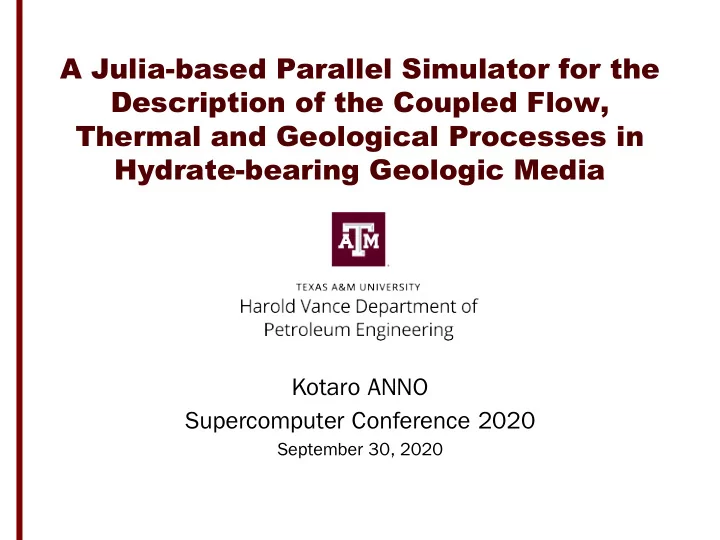

A Julia-based Parallel Simulator for the Description of the Coupled Flow, Thermal and Geological Processes in Hydrate-bearing Geologic Media Kotaro ANNO Supercomputer Conference 2020 September 30, 2020
Outline • Background • Objective • Methodology • Simulation Results • Summary A Julia-based Parallel Simulator for the Description of the Coupled Flow, Thermal 2 and Geological Processes in Hydrate-bearing Geologic Media, Kotaro Anno
Background • A Julia-based Parallel Simulator for the Description of the Coupled Flow, Thermal 3 and Geological Processes in Hydrate-bearing Geologic Media, Kotaro Anno Reference: National Energy Technology Laboratory
Objective • A Julia-based Parallel Simulator for the Description of the Coupled Flow, Thermal 4 and Geological Processes in Hydrate-bearing Geologic Media, Kotaro Anno
Methodology • A Julia-based Parallel Simulator for the Description of the Coupled Flow, Thermal 5 and Geological Processes in Hydrate-bearing Geologic Media, Kotaro Anno
Field scale problem • • Typical job size • HPRC Cluster: Ada • Software: Julia, MPI, LIS, and METIS • Cores: 128 • Memory: 2560 MB per processors • Run time: 2 hours A Julia-based Parallel Simulator for the Description of the Coupled Flow, Thermal 6 and Geological Processes in Hydrate-bearing Geologic Media, Kotaro Anno
Simulation Results and Validation Cumulative Mass of released methane gas Mass rate of the CH4 gas release from hydrate Cumulative mass of the CH4 gas released from dissociation in the 2D field scale problem hydrate dissociation in the 2D field scale problem A Julia-based Parallel Simulator for the Description of the Coupled Flow, Thermal 7 and Geological Processes in Hydrate-bearing Geologic Media, Kotaro Anno Reference: TOUGH_HYDRATE v1.5, Moridis (2014)
Simulation Results Spatial Distribution of Pressure Spatial Distribution of Gas Phase Saturation Pressure distribution in the well vicinity at the end Gas saturation distribution in the well vicinity at the of simulation in the 2D field scale problem end of simulation in the 2D field scale problem Depressurization works and gas is evolved around the well A Julia-based Parallel Simulator for the Description of the Coupled Flow, Thermal 8 and Geological Processes in Hydrate-bearing Geologic Media, Kotaro Anno Reference: TOUGH_HYDRATE v1.5, Moridis (2014)
Computational Performance Speed up and Efficiency Total Elapsed Time The relationship between total elapsed time and number The relationship between speed up, efficiency and of processors in the study of field scale problem number of processors in the study of the study of filed scale problem A Julia-based Parallel Simulator for the Description of the Coupled Flow, Thermal 9 and Geological Processes in Hydrate-bearing Geologic Media, Kotaro Anno
Summary • The JFTS+H simulator was developed to model the coupled flow, thermal/thermo-dynamics and chemical processes associated with the formation and dissociation of hydrate in geologic media. • The JFTS+H code has been validated against the TOUGH+HYDRATE v1.5 simulator. • The JFTS+H simulator can simulate field-scale problems of gas production from hydrate deposits. • Analysis and evaluation of the computational performance of JFTS+H shows conclusively that the MPI-based parallel version of the code delivers a significant and scalable speed-up. A Julia-based Parallel Simulator for the Description of the Coupled Flow, Thermal 10 and Geological Processes in Hydrate-bearing Geologic Media, Kotaro Anno
A Julia-based Parallel Simulator for the Description of the Coupled Flow, Thermal and Geological Processes in Hydrate-bearing Geologic Media Kotaro ANNO kotaro369@tamu.edu September 30, 2020
Reference • The Julia Programming Language(https://julialang.org/) • Karypis, G., METIS: A Software Package for Partitioning Unstructured Graphs, Partitioning Meshes, and Computing Fill-Reducing Orderings of Sparse Matrices version 5.1.0, Department of Computer Science & Engineering, University of Minnesota, 2013. • Moridis, G.J., and K. Pruess, User’s Manual of the TOUGH+ v1.5 Core Code: A General-Purpose Simulator of Non-Isothermal Flow and Transport Through Porous and Fractured Media, Lawrence Berkeley National Laboratory Report LBNL-6869E, August 2014. • Moridis, G.J, User’s Manual of the Hydrate v1.5 option of TOUGH+ 1.5: A Code for the Simulation of System Behavior in Hydrate-Bearing Geologic Media, Lawrence Berkeley National Laboratory Report LBNL-6869E, August 2014. • Nishida, A., Experience in developing an open source scalable software infrastructure in Japan. In: Computational Science and Its Applications-ICCSA 2010. Lecture Notes in Computer Science, Vol. 6017, 2010. • NATIONAL ENERGY TECHNOLOGY LABORATORY (https://netl.doe.gov/oil-gas/gas-hydrates) A Julia-based Parallel Simulator for the Description of the Coupled Flow, Thermal 12 and Geological Processes in Hydrate-bearing Geologic Media, Kotaro Anno
Recommend
More recommend